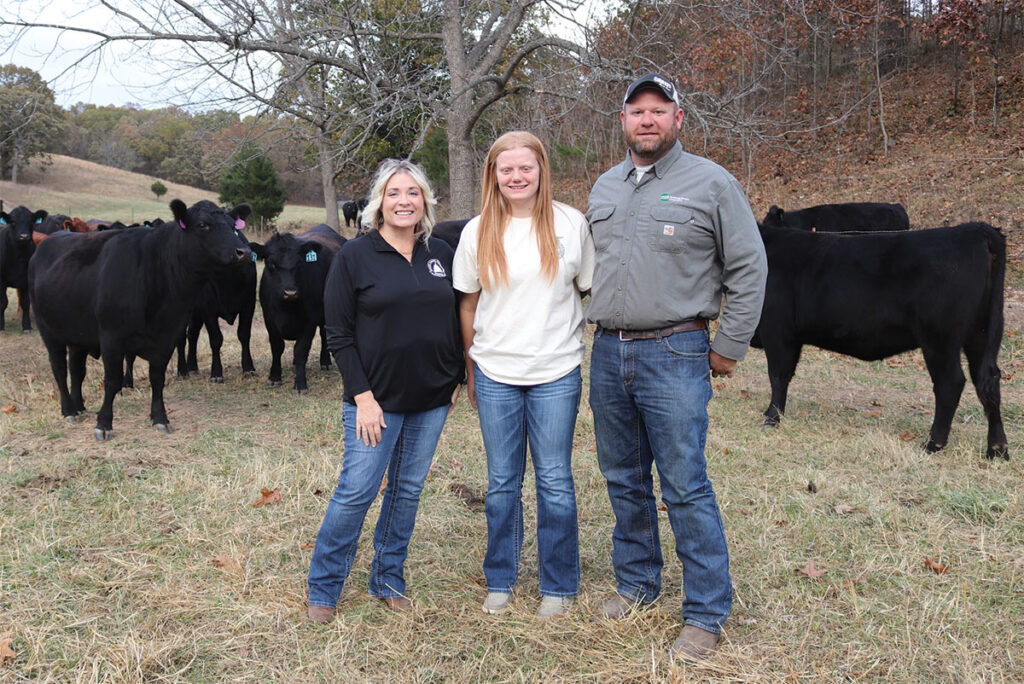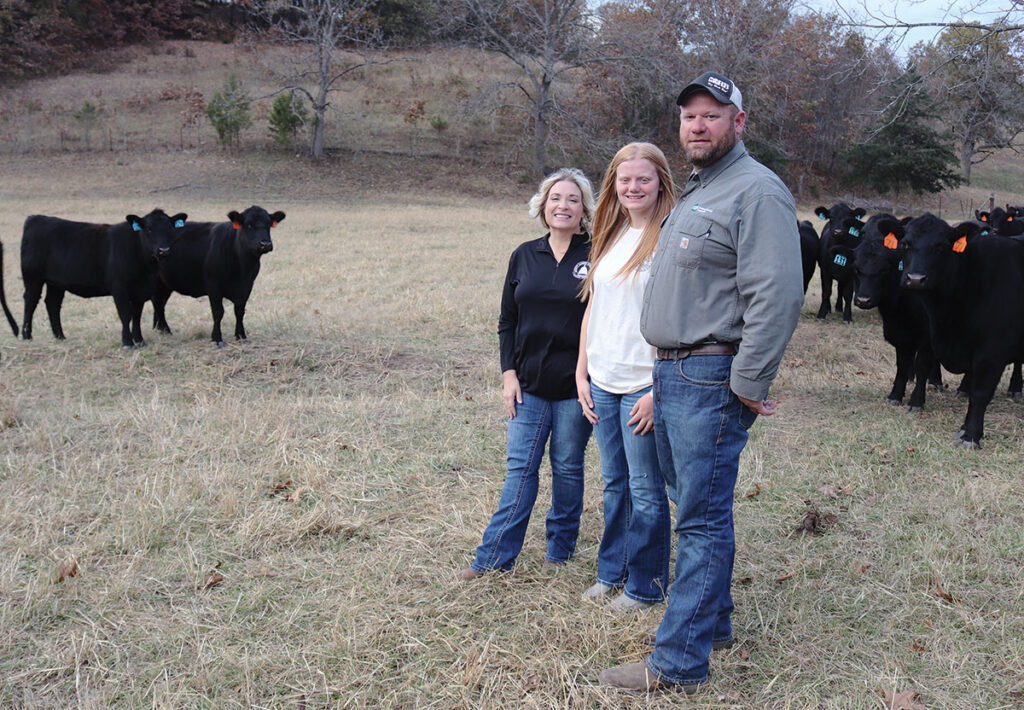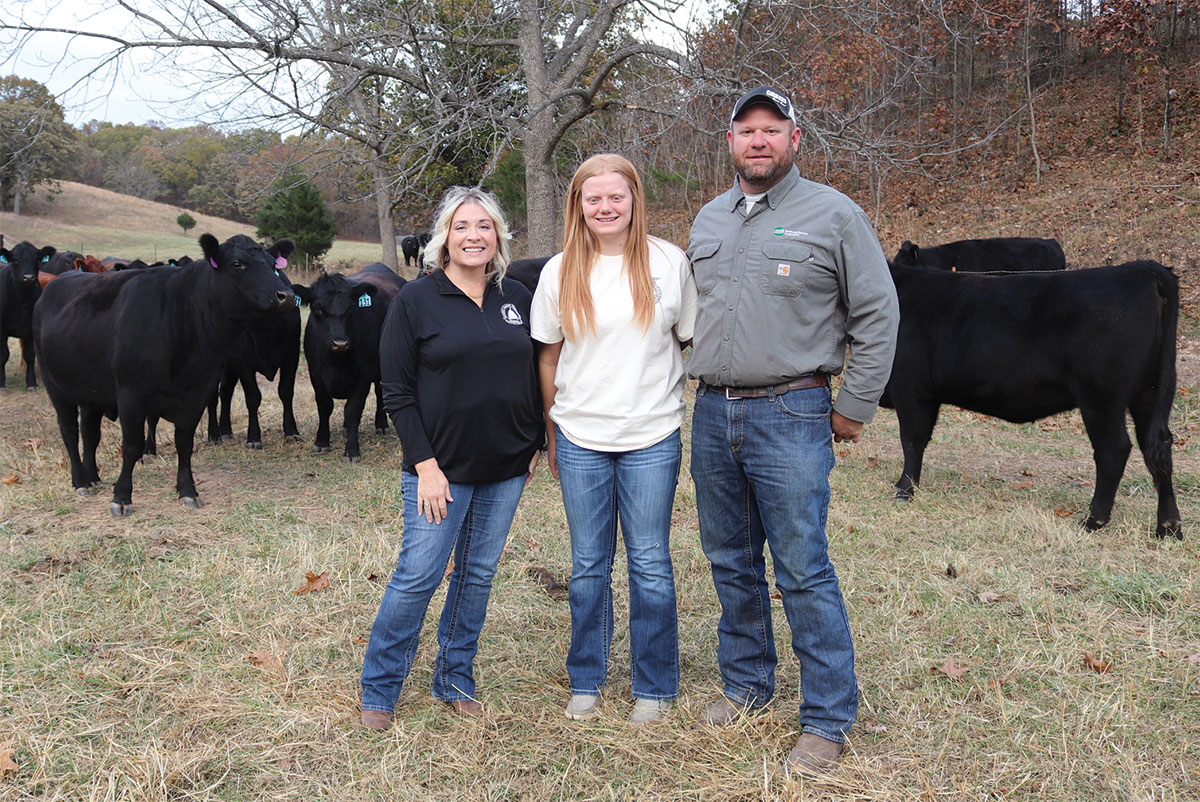
Farm-raised beef and quality heifers are the goal of the Campbell family
MACKS CREEK, MO. – “Big Rock” pays homage to a massive rock formation protruding from the landscape at one Camden County, Mo., farm, and the family who has called the property home for four generations has a solid foundation in the cattle industry.
Jarrod Campbell’s grandparents bought the farm near Macks Creek during World War II. His mother grew up on the property, where Jarrod now calls home. Sharing his life under the rock is his wife, Kathy, and his daughters, Makenna and Kassidy, the fourth generation on the farm.
“We’ve had cattle here as long as I can remember,” Jarrod, who began to establish a herd while still in high school, said.
“We’ve had cattle here as long as I can remember,” Jarrod, who began to establish a herd while still in high school, said.
The family’s background is in commercial cow/calf production, but Jarrod decided to take the operation in a slightly different direction.
“We had a neighbor who moved in from Illinois, so we bought a registered Angus bull from him,” Jarrod said. “Over the years, he and I got close and partnered with registered black Angus. He liked selling bulls, and we sold a few replacement heifers along the way.”
Sadly, Jarrod’s partner and mentor, Roger Martens, passed away in 2021, but Jarrod continues to run a mainly straight Angus herd of about 50 cows on more than 250 acres.
When COVID hit, Jarrod saw cattle prices drop due to supply chain issues. The slump prompted Jarrod to direct marketing beef, and Big Rock Beef began.
“We prayed about it, and I think God laid out a sign for us. We ended up keeping that group of calves, and Kathy picked up quite a few people to sell beef to,” Jarrod said. “Over the years, we’ve sold to neighbors and always had our fresh beef. I always wanted to go toward the direction of putting together replacement heifers and selling beef to people, and that’s the way we are heading.”
Big Rock Beef offers small groups of calves for processing.
“I might take two to the processor in October, then two in December,” Kathy said. “We have two calving seasons, so as we bring them around, we can look at that group, and if we have heifers, we can decide if we have any breeding stock animals or culls. We’re keeping the best of what we want, and we still have more than one path for them.”
Calves going into the beef program are vaccinated and wormed at weaning, then moved to pasture.
“We hand feed them once a day, and they have hay in the winter,” Jarrod explained. “We don’t push them hard but want to keep that marbling growing. When they get toward the end, they only get about 10 pounds of feed a day.”
Spring and fall calves are in the same pasture after weaning.
“We aren’t taking five, pulling them out and hitting them with the same feed every day in a dry lot; they are wondering on pasture and eating when they choose,” Kathy said. “As they get close to butchering, they are a little hoggish when the feed comes out, and the little ones aren’t getting as much. We continue to peel off the top, and they all move up. After three or four years of doing this, it’s the formula we like. Other than weaning, they are never in a dry lot.”
Demand has been good for Big Rock Beef, with many repeat customers.
“Our beef speaks for itself,” Jarrod said. “We haven’t had any complaints.”
“Before, some of the limitations were people not having a freezer, but when people got over that hump or got started with farm-fresh beef, they never want to go back,” Kathy added.
Calves are typically processed at around 1,000 pounds after receiving a three-way commodity ration. About 20 head are expected to be sent to processing this year, with customers buying beef by the hanging weight.
“That puts a carcass hanging at about 600 pounds,” Jarrod explained. “It seems to be about right for the people buying from us. For a family of four, buying a half will last them a good portion of a year.
“We need to stay small and focus on the product. It would tickle me to death to never sell a calf at the sale barn again; just sell them all private treaty, either as replacements or beef.”
Kathy and Jarrod said their customers appreciate that Big Rock Beef is a 100 percent local product.
“They are born here or across the road at our other place,” Jarrod said. “From the day they are born to the day they go to the packing house, they never leave the property.”
With few exceptions, the Campbells have generations of records for each female.

“Every cow on this place, I raised their momma,” Jarrod said. “I take pride in that they are still holding together and that we are tightening our calving window each year.”
In addition to beef sales, the Campbells are moving into the bred replacement heifer market.
“We have two horned Hereford bulls with our older cows that are being used to produce F1 baldies,” Jarrod said. “They seem to always top the market and are highly-sought replacements. Roger and I had always talked about doing it, but we never did. We always used a black bull on our heifers, and we’re keeping him to keep the straight-bred cows.”
Replacement heifers are confirmed bred, tagged and documented. Like the beef program, the family can share the history of the heifer’s dam and sire.
“We don’t have large groups of heifers; we want to focus on the quality of those heifers,” Jarrod said.
The Hereford bulls, Kathy, who grew up on a farrow-to-finish hog and cow/calf farm in Northern Missouri, continued, will also benefit the beef program.
“We looked at several studies where we could get that faster weight gain without losing the taste, marbling, and consistency we were looking for,” she said. “Also, it’s another marketable animal if we decided to take a group on to market.”
The Campbells plan to begin pelvic measurements and condense their calving windows as they begin marketing heifers.
“With the genetics in this herd, over time and selection made for cull/keep, our replacement groups have been running 10 to 15 heads without any problems,” Kathy added. “We have a bull with the heifers now that has leggy calves, but they hit the ground light and have been gainers.”
Heifers enter the breeding program at about 14 to 16 months of age. Heifers that do not breed the first time are culled or moved into the beef program. Second-calf heifers are sometimes switched from one breeding season to the next if they raised a quality calf.
Temperament is a culling factor for the Campbells. With his job as a lineman with Southwest Electric, Jarrod is called out on emergencies and can be gone for extended periods, so he wants cattle Kathy, his daughter or his parents can care for without fear.
Big Rock Beef and the Campbells plans to reinstate an AI program and to improve the herd’s genetics to fit their farm goals.
“I want to look at the ones that do well being grass-finished,” Jarrod said. “They do well on the fescue, and people who are gearing toward grass-dominant genetics, it seems like their cattle hold together. We like moderation in the size of our cows, 1,100-pound tops.”
They have also discussed adding farm-raised pork to their offerings.
“We do think there is interest in small-batch hogs,” Kathy said. “We wouldn’t have them in confinement, and I think people would like to talk to us, just like they do with the beef.”
Improvements to the farm include revamping working facilities, running waterlines, and sectioning off pastures to improve pasture rotation.
Jarrod’s goal of offering quality replacement animals and beef program has come to fruition, but there’s always more to do.
“As a farmer, you are always striving for more,” he said. “I feel like we’re on the cusp of where we want to be, but I always want to improve what we have. I want to make sure we’re doing things on our end that will make these heifers good heifers for others, just like their mommas have been for us. On the beef, every time someone pulls out a steak, I want it to be as good as the steak they had before, or even better. Our desire is to keep doing a little better.”







